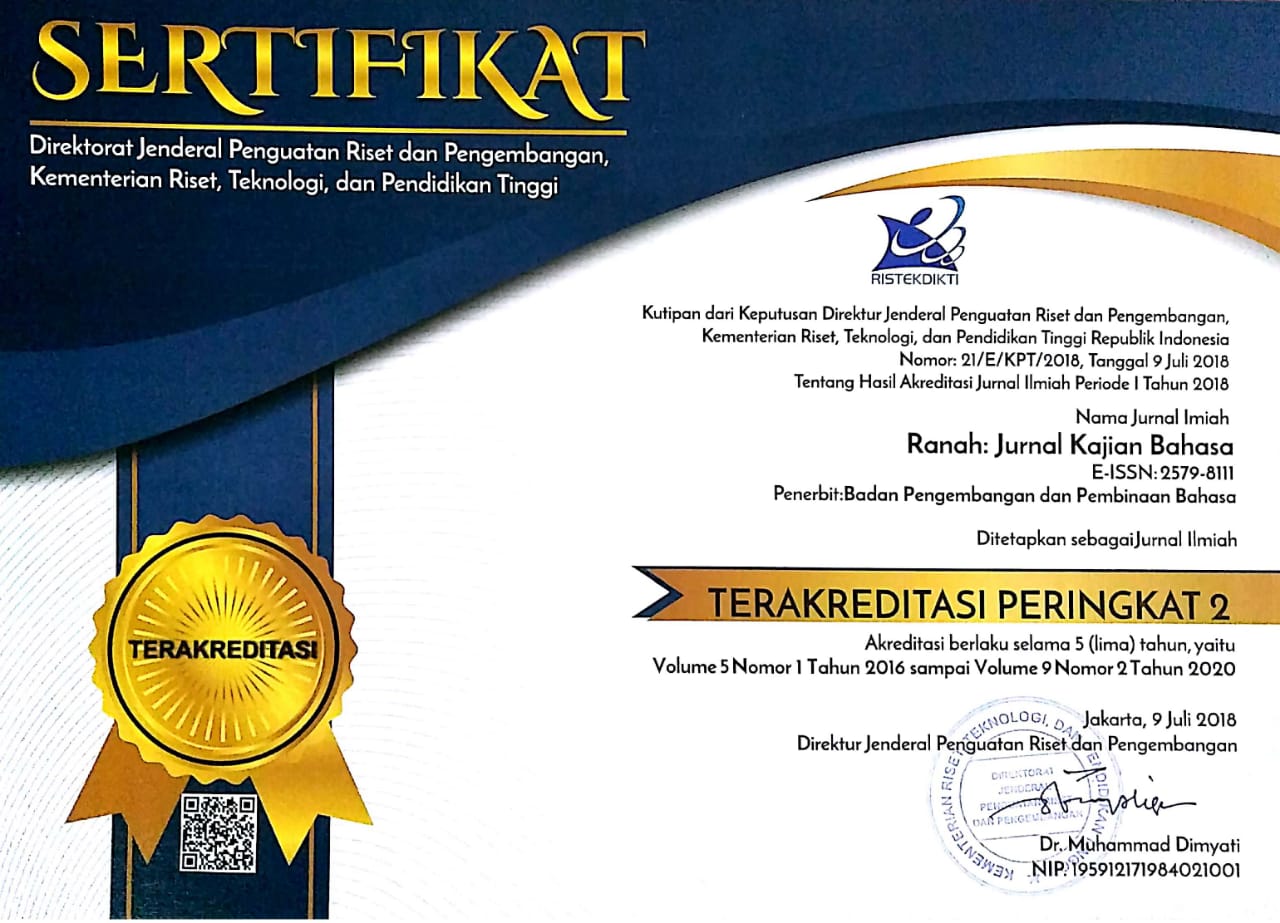Tinjauan Komparatif Bahasa Arab dan Bahasa Inggris Aforisme Al-Hikam: Analisis Sintaksis
Abstract
This article will investigate the Arabic language and English language based on Syntax analysis. In this case, syntax had been viewed as the arrangement between certain word and the other word, or with the other units of language which has the higher level than the word, such as: phrase, clause, and sentence. Generally speaking, this research will investigate the Arabic language based the four main theory in syntax (Liliane Haegeman, 1998), such as: (1) transitivity, (2) X-bar theory, (3) theta theory, and (4) case theory. This article will focus comprehensively in elaborating the data, both in Arabic language and English language, comparatively based on these four main theories. The material objects in this research was the units of language which had been collected from the book of Al-Hikam aphorism in trilingual edition (Arabic, Indonesia, and English). The observation method had been used for collecting the data, after that, the data will be analysed with two main steps, they are: distributional method and comparative method. Transitive verbs in al-Hikam's aphorisms show God's behavior. The transitivity of verbs in Arabic is determined by the noun that comes after the verb. Meanwhile, based on the study of X-Bar theory in Arabic phrases that appear in al-Hikam's aphorisms, it can be concluded that the internal structure of noun phrases, that FN = N + Adj and FN = N + N. Furthermore, in the theta theory analysis, it can be concluded that FN in the form of (N + Adj) can occupy the AGENT position and FN in the form of (N + N) can occupy the PATIENT argument to form a propositional unit. Based on the case theory study, it can be concluded that the NOMINATIVE case is in the subject who acts as the AGENT, and the ACCUSATIVE case is in the direct object that becomes the object of the sufferer or target, namely acting as the PATIENT. The result of this research can be the new model of Arabic and English language analysis based on the syntax theory.
Abstrak
Artikel ini akan mengkaji bahasa Arab dan bahasa Inggris ditinjau dari sudut pandang sintaksis. Dalam hal ini, sintaksis dipandang sebagai pengaturan hubungan antara kata dengan kata, atau dengan satuan yang lebih besar dalam bahasa. Secara garis besar kajian ini akan menginvestigasi bahasa Arab ditinjau dari kajian empat teori sintaksis (Haegeman, 1998), yaitu: (1) transitivity, (2) X-bar theory, (3) theta theory, dan (4) case theory. Adapun secara khusus, artikel ini akan mengelaborasi data bahasa Arab dan bahasa Inggris secara komparatif berlandaskan pada keempat teori tersebut. Objek material dalam kajian ini adalah satuan kebahasaan (units of language) yang ada dalam kitab aforisme al-Hikam versi tiga bahasa (Arab, Indonesia, dan Inggris). Penjaringan data dilakukan dengan cara observasi kemudian data dianalisis dengan menggunakan dua tahap, yaitu: metode distribusional dan metode padan. Verba transitif dalam aforisme al-Hikam menunjukkan perilaku ketuhanan tertentu. Ketransitifan verba dalam bahasa Arab ditentukan oleh nomina yang muncul setelah verba. Sementara itu, berlandaskan pada kajian X-Bar theory dalam frasa bahasa Arab yang muncul dalam aforisme al-Hikam dapat disimpulkan struktur internal frasa nomina, bahwa FN = N + Adj dan FN = N + N. Selanjutnya dalam analisis theta theory, dapat disimpulkan bahwa FN yang berupa (N + Adj) dapat menduduki posisi agent dan FN yang berupa (N + N) dapat menduduki argumen patient untuk membentuk sebuah satuan proposisi. Berlandaskan pada kajian case theory dapat disimpulkan bahwa kasus nominatif berada dalam subjek yang berperan sebagai agent, dan kasus akusatif berada dalam objek langsung yang menjadi penderita atau sasaran, yaitu berperan sebagai patient. Kontribusi pembahasan dari kajian ini diharapkan dapat memberikan wawasan baru dalam kajian bahasa Arab dan bahasa Inggris yang ada di Indonesia, khususnya terkait dengan kajian sintaksis (Arab: Ilmu-Naḥwu).
Keywords
Full Text:
PDF (Bahasa Indonesia)References
Alasmari, Jawharah, Janet C. E. Watson, and D. Eric Atwell. (2017). Using the Quranic Arabic Corpus for Comparative Analysis of the Arabic and English Verb Systems. International Journal on Islamic Applications in Computer Science and Technology 5(3): 1-8.
Almarshedi, Raniyah Mohammad. (2022). Linguistic Awareness or Grammatical Competence: What Dominates the Saudi Undergraduate EFL Classroom?. Theory and Practice in Language Studies 12(10): 79-88. https://doi.org/10.17507/tpls.1210.04
Althawab, Abdulrahman, A. (2022). The Syntactic Structure of an Introductory PP in Standard Arabic: A Non-Transformational Approach. World Journal of English Language 12(8): 242. doi: https://doi.org/10.5430/wjel.v12n8p242
Althawab, Abdulrahman, A. (2022). The Syntax of the Negation Marker Laa in Najdi Arabic: An HPSG Approach. World Journal of English Language 12(6): 402. https://doi.org/10.5430/wjel.v12n6p402
Alwi, Hasan, Soenjono Dardjowidjojo, Hans Lapoliwa, and Anton M. Moeliono. (2003). Tata Bahasa Baku Bahasa Indonesia: Edisi Ketiga. Jakarta: Balai Pustaka.
Anis, Muhammad Yunus, Eva Farhah, and Reza Sukma Nugraha. (2022). Dasar-Dasar Sintaksis Bahasa Arab . Yogyakarta: Penerbit Deepublish CV Budi Utama.
Arummi, Afnan. (2020). A Theoretical Review of General Linguistic on Linguistic Phenomena in Arabic Language. Center of Middle Eastern Studies (CMES): Jurnal Studi Timur Tengah 15(1):123-37.
Baalbaki, Ramzi Munir. (1990). Dictionary of Linguistic Terms English - Arabic. Beirut: Dar el-Ilm Lil-Malayin.
Băiaş, Cosmin-Constantin. (2015). The Aphorism: Function and Discursive Strategy. Procedia - Social and Behavioral Sciences 191:2267-71. https://doi.org/10.1016/j.sbspro.2015.04.229
El-Dahdah, Antoine. (1993). A Dictionary of Arabic Grammatical Nomenclature: Arabic - English. Beirut: Librairie du Liban Publishers.
Firdaus, W. (2011). Kata-Kata Serapan Bahasa Aceh dari Bahasa Arab: Analisis Morfofonemis. Sosiohumaniora, 13(2), 223.
Haegeman, Liliane. (1998). Introduction to Government and Binding Theory. Oxford: Blackwell Publishers Ltd.
Halimah, Ahmad Mustafa, and Zainab R Aljaroudi. (2019). Translating English-Arabic Business-to-Consumer Advertisements: A Domesticating Approach. World Journal of English Language 9(2): 42. https://doi.org/10.5430/wjel.v9n2p42
Hazout, Ilan. (1990). Verbal Nouns: Theta Theoretic Studies in Hebrew and Arabic. University of Massachusetts, Amherst.
Herliana, Monika. (2018). Struktur Frase Nominal Bahasa Mandarin Berdasarkan Teori X-Bar. Jurnal Cakrawala Mandarin 2(1): 46-57. https://doi.org/10.36279/apsmi.v2i1.48
Kridalaksana, Harimurti. (2009). Kamus Linguistik: Edisi Keempat. Jakarta: PT Gramedia Pustaka Utama.
Mahmoud. (2010). Dictionary of Literary and Linguistic Terms English Arabic. Cairo: Ad-Dar al-Mishriyyah lil-Kitab.
Mohamed Khalil Ennassiri. (2015). Principles and Parameters Theory: Towards a Contrastive Syntax of English and Arabic. Morocco: Imprimerie Al-Khalij Al Arabi.
Mukramah and Mulyadi Mulyadi. (2022). Konstruksi Interogatif dalam Bahasa Aceh: Teori X-Bar. Ranah: Jurnal Kajian Bahasa 11(1). https://doi.org/10.26499/rnh.v11i1.2114
Mulyadi. (2010). Frase Preposisi Bahasa Indonesia: Analisis X Bar. Kajian Sastra: Jurnal Bidang Kebahasaan dan Kesusastraan 34(1). 1-12.
Pustaka, Tim Wali. (2016). Al-Hikam: Kitab Rujukan Ilmu Tasawuf Edisi Lengkap 3 Bahasa. Jakarta: Wali Pustaka.
Richards, Jack C., and Richard Schmidt. (2007). Longman Dictionary of Language Teaching and Applied Linguistics. London: Longman Group.
Said Ghazala, Hasan. (2012). Translating the Metaphor: A Cognitive Stylistic Conceptualization (English - Arabic). World Journal of English Language 2(4). https://doi.org/10.5430/wjel.v2n4p57
Shamsan, Muayad. (2018). Theta Roles Assigned to Subject Argument in Arabic and English Passive Voice. International Journal of Applied Linguistics & English Literature. 7(7): 47-51. https://doi.org/10.7575/aiac.ijalel.v.7n.7p.47
Sterling, R. (2018). A Grammar of the Arabic Language. Oxon: Taylor & Francis. https://doi.org/10.4324/9780429462122
DOI: https://doi.org/10.26499/rnh.v11i2.2872
Refbacks
- There are currently no refbacks.








